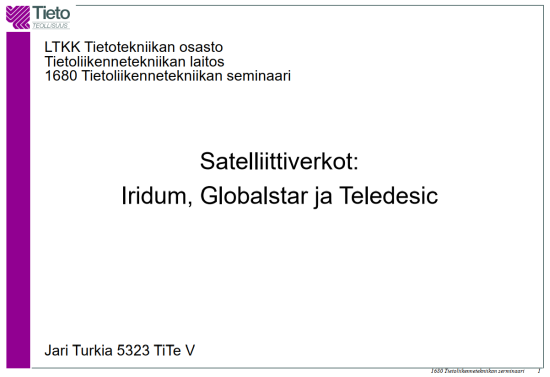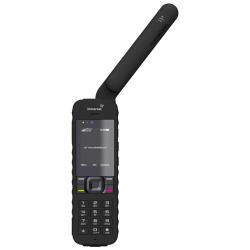Satellite Internet — Past & Present
Saturday, March 4. 2023
About satellites
ESA has a really good information package Space Transportation - Types of orbits.
When context is satellite Internet, there are pretty much three options: LEO, MEO or GEO. As satellites fly high, latency from Earth's surface to satellite and back is a factor. Low Earth Orbit is the most common choice, altough the lower you fly, the more satellites are required for reasonable coverage.
Past
Inspiration for this blog post came from my 1998 LUT course presentation of Satellite Internet. 25 years ago IT-bubble was still growing and it was about two years before it bursted. As I was a telecommunications major, I took a seminar course which contained a presentation. From the list of topics available, apparently I chose satellite Internet. Back in those days getting the bandwidth delivered to everybody was in rapid growth. Mobile Internet was mostly non-existent, fiber-to-the-home was non-existent, dial-up model, ADSL or cable-TV internet were the methods for getting to The Net.
Here is my PDF presentation about satellite networks Iridium, Globalstar and Teledesic (in Finnish):

This past can be considered as Round #1 of satellite internet.
Retrospective: Iridium
Went into production. 2nd generation begun deploying in 2017. Not generally known, nor common. Originally, not financially viable.
Retrospective: Globalstar
https://www.globalstar.com/, LEO
Went into production. 2013 2nd generation, 2018 3rd generation announcement. Apple iPhone 14 emergency messages are using 2nd gen Globalstar. Not generally known, nor common. Originally, not financially viable.
Retrospective: Teledesic
Never saw production. Project suspended 2002 as IT-bubble bursted and saw financial problems of Iridium and Globalstar. Completely vaporware and nobody knows this ever existed. Plan was to have hundreds of LEO satellites for really fast Internet connectivity.
I have to mention their tech. Instead of traditional approach all others have, relying on ground station being able to find a passing satellite, Teledesic originally planned having 840 satellites. As it was extremely expensive, they later reduced the number to 288. Their idea was to map Earth into regions and having enough capacity, multiple satellites were available at one "square" at a time to provide massive speeds. In theory, really good idea!
Other services
My presentation contained only three companies/services as the topic given to me dictates. At the time, other satellite services did exist.
Still today, Inmarsat Broadband is well known for its voice capabilities and mobile units made famous in popular culture. They do support broadband connection in their GEO satellites. This Satphone 2 is a well-known product:

Another not well-known service is ORBCOMM, an IoT service provider. As their service is targeted to hardware manufacturers, not consumers, nobody has not ever heard of this one. Their 50+ satellites are LEO.
Present
Fast-forward to today.
Obviously Iridium, Globalstar, Inmarsat and ORBCOMM do still exist. As there are some changes in service offering for the past 25 years, let's do a recap of the new players.
SpaceX Starlink
https://www.starlink.com/, very low LEO
Mr. Musk and his Starlink is getting tons of media attention, especially for his donation of terminals to Ukraine to help them in war against Russia. This well-known service is farthest from vaporware, is affordable and easily available. Broadband speed is reasonable, see Ookla Speedtest results comparison.
Notable fact about Starlink is, they are the only satellite broadband provider so far to have their own vehicle for orbiting their own satellites. This capability will give them much required longevity. Satellite Internet is not a sprint, after all.
HughesNet / EchoStar
https://www.hughesnet.com/, GEO
Originally Hughes Communications was owned by Hughes Aircraft, the company founded by Howard Hughes. They are a major service provider in Americas. Here in Europe, they're not well known.
Viasat
https://www.viasat.com/space-innovation/satellite-fleet/viasat-3/, GEO
This is an upcoming broadband service. Viasat is a known satellite-TV operator expanding its services to Internet.
Amazon / Project Kuiper
Obviously Mr. Bezos want's to compete against his nemesis, Mr. Musk and launch his own satellite Internet. His project is the most recent one and really doesn't even have a proper website.
Boeing
LEO
The legendary aircraft manufacturer wants their share of satellite Internet business. This very recent project has FCC approval for 147 satellites, but not much is known about the project.
Future?
As we learned back in 2002 when Teledesic folded, there isn't room for all above players. Some of them will fold and/or merge. Especially SpaceX is gaining lot of customers in rural areas with their modern service offering. Having a fierce battle-of-pricing won't be happening. Launching those satellites is v e r y expensive. Lacking financial stability, not everybody will survive in this Round #2.
There is plenty of space in the sky. It is already crowded and traffic jam is likely to get worse as more and more satellites are launched. Just take a look at Wikipedia's Satellites orbiting Earth -article.

